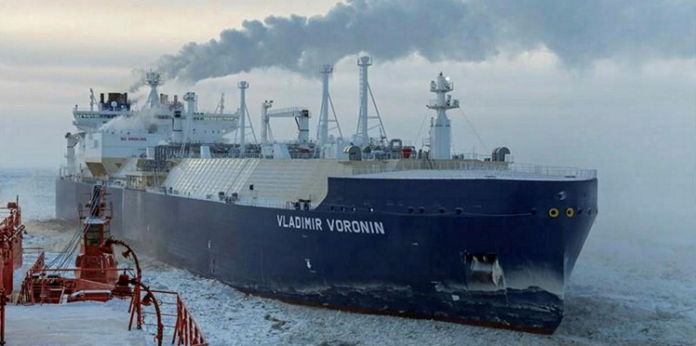“ARC 7” is a classification of liquefied natural gas (LNG) tankers. It represents a specific type of LNG carrier designed to operate in harsh Arctic conditions. The term “ARC” stands for Arctic, indicating that these tankers are specifically built to navigate through icy waters and extreme cold temperatures. LNG transportation from Ob Bay in Russian Arctic focus on the west-bound route to Europe, and on the east-bound route to Asia along the Northern Sea Route. The new Arc7 design allows transportation all year round on this challenging itinerary. LNG transportation from Ob Bay in Russian Arctic will, in the future, focus on the west-bound route to Europe, and on the east-bound route to Asia along the Northern Sea Route. The new Arc7 design allows transportation all year round on this challenging itinerary.

Image source: trade winds
ARC 7 LNG tankers typically feature reinforced hulls, powerful icebreaking capabilities, and advanced technology to ensure safe transportation of LNG across Arctic routes. These vessels are crucial for exploiting the vast natural gas reserves in the Arctic region and transporting LNG to global markets.
The classification system for LNG tankers is developed by organizations such as classification societies (e.g., DNV GL, Lloyd’s Register) and regulatory bodies to ensure that vessels meet certain standards for safety, environmental protection, and operational efficiency.
ARC 7 tankers play a significant role in the development of Arctic energy resources and the expansion of LNG trade routes. They enable access to remote areas with rich natural gas reserves that were previously inaccessible due to harsh environmental conditions.
DEVELOPING THE ARTIC LNG FLEET
Russia’s largest independent gas producer OAO Novatek and French energy major Total S.A. are in partnership developing LNG plant a project on the eastern coast of Yamal Peninsula in the village of Sabetta. China National Petroleum Corporation, CNPC has additionally join the project as well as a con of supply of firmed minimum 3 million tons of gas per annum. The Arctic location presents challenges for exports of the liquefied natural gas and Aker Arctic has been actively involved in researching and creating solutions for JSC Yamal LNG since 2010. In 2018, when Novatek announced that they wanted to explore year-round use of the NSR, Aker Arctic began to investigate how the first generation of LNG carriers could be improved in order to lower overall transportation costs. A joint development project with Novatek was initiated, first with transit simulations for different vessel concepts, seeking the optimal solution for the new route and period of time, followed by design work for the improved vessel
concept.

Image source: Aker Artic
The steel cutting ceremony for the lead Arc7 ice-class LNG vessel was held in November 2020, followed by the ceremonies for the second and third ships in the series in January 2021, and April 2021, respectively. The first steel for the sixth and seventh ships in the series was cut in December 2021 and February 2022, respectively. The construction of the Arc7 ice-class LNG tanker is significantly challenging, as the construction of Arctic class gas carrier vessels is a technologically complex process in the shipbuilding industry. The Zvezda Shipyard Complex is the first company to undertake the construction of liquefied gas tankers in Russia. Zvezda utilize equipment specific to Russian shipyards and the latest technologies for the construction of Arc7 ice-class tanker. The first part of the Arc7 ice-class tanker under construction was cut in the hull production unit, using a high-tech plasma-cutting machine.
Author: Amrith Krishna




